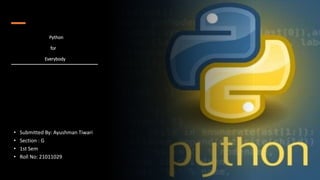
Presentation.pptx
- 1. Python for Everybody • Submitted By: Ayushman Tiwari • Section : G • 1st Sem • Roll No: 21011029
- 2. TABLE OF CONTENTS 1 History of Python . 2 Why to choose Python. 3 Characteristics of Python. 4 Data Structures in Python. 5 Uses Of NumPy 6 Conclusion
- 3. History of Python • Python was developed in 1980 by Guido van Rossum at the National Research Institute for Mathematics and Computer Science in the Netherlands as a successor of ABC language capable of exception handling and Interfacing . Python features a dynamic type system and automatic memory management . It supports multiple programming paradigms, including object oriented programs , imperative , functional and procedural , and has a large and Comprehensive standard library. • Van Rossum picked the name Python for the New language from a TV show , Monty Python's Flying Circus. • In December 1989 , I was looking for a "hobby" programming project that would keep me occupied during the week around Christmas. My office … would be closed , but I had a home computer , and not much else on my hands . I decide to write an interpreter for the new scripting language I had been thinking about lately : as a descendent of ABC that would appeal to Unix/C hackers. I chose Python as a working title for the Project. • - Guido Van Rossum
- 4. Why To Choose Python • The language's core philosophy is summarized in the Document "The Zen of Python", which include aphorisms such as : • Beautiful is better than Ugly. • Simple is better than Complex. • Complex is better than Complicated. A Simple Program to print "Hello World" JAVA CODE PYTHON CODE public class HelloWorld { public static void main(String args []) { System.out.println("Hello World") } } print ("Hello World")
- 5. Characteristics Of Python Interpreted Language : Python is processed at runtime by Python Interpreter. Easy To Read : Python source-code is clearly defined and visible to eyes. Portable : Python codes can run on wide variety of hardware platforms having the same platforms. Extendable: Users can add low level modules to Python interpreter. Scalable: Python provides an improved structure for supporting large programs than shell-scripts. Object-Oriented Language: It supports object- oriented features and techniques of Programming.
- 6. Data Structures In Python • Lists: • Ordered Collection of Data. • Supports similar slicing and Indexing functionalities as in case of String. • They are mutable. • Example: my_list = ['one' , 'two' , 'three',4,5] • Len(my_list) would output 5. • Dictionary: • Lists are sequences but the Dictionaries are mappings. • These mappings may not retain order. • Accessing object from a dictionary. • Nesting Dictionaries. • Basic Syntax: d={} empty dictionary will be generated and assign keys and values to it liked['animal']='Dog'.
- 7. Sets: A set contains unique elements and we can construct them by using a set() function. Convert a list into set: I=[1,2,3,4,1,1,2,3,6,7] K=set(I) K becomes{1,2,3,4,6,7} Basic Syntax: X=set() x.add(1) X={1} x.add(1) There would not be any change in x now.
- 8. Uses Of NumPy • NumPy is Python package. It stands for "Numerical Python". It is a library consisting of Multidimensional Array Objects and a collection of routines for processing an Array. • Operations using NumPy: • Using NumPy , a developer can perform the following operations: • Mathematical and logical operations on Array. • Fourier transforms and routines of shape manipulation. • Operations related to linear Algebra. NumPy has in-built functions for linear algebra and random number generation. • Example: • Import NumPy as np • b=np.array([[1,6,5,2,3,45]]) • b.shape=(3,2) • Print(b) • [[1 6] • [5 2] • [3 45]]
- 9. Conclusion I BELIEVE THAT THIS TRIAL HAS SHOWN CONCLUSIVELY THAT IT IS BOTH POSSIBLE AND DESIRABLE TO USE PYTHON AS THE PRINCIPAL TEACHING LANGUAGE AS : IT'S FREE (AS IN BOTH COST AND SOURCE- CODE) IT IS TRIVIAL TO INSTALL ON A WINDOWS PC ALLOWING STUDENT TO TAKE THEIR INTEREST FURTHER . IT IS A FLEXIBLE TOOL THAT ALLOWS BOTH LEARNING AND TEACHING PROGRAMMI NG. IT IS A REAL WORLD PROGRAMMING LANGUAGE THAT CAN BE USED IN COMMERCIAL WORLD. AND THE MOST IMPORTANT , IT'S CLEAN SYNTAX OFFERS INCREAS ED UNDERSTANDING AN D ENJOYMENT OF STUDENTS. IN MY OPINION I HAVE GAINED LOTS OF KNOWLEDGE AND EXPERIENCE NEEDED TO BE A SUCCESSFUL IN ENGINEERING . AS AFTER ALL ENGINEERING IS A CHALLENGE AND NOT JUST A JOB.
- 10. • THANK • YOU